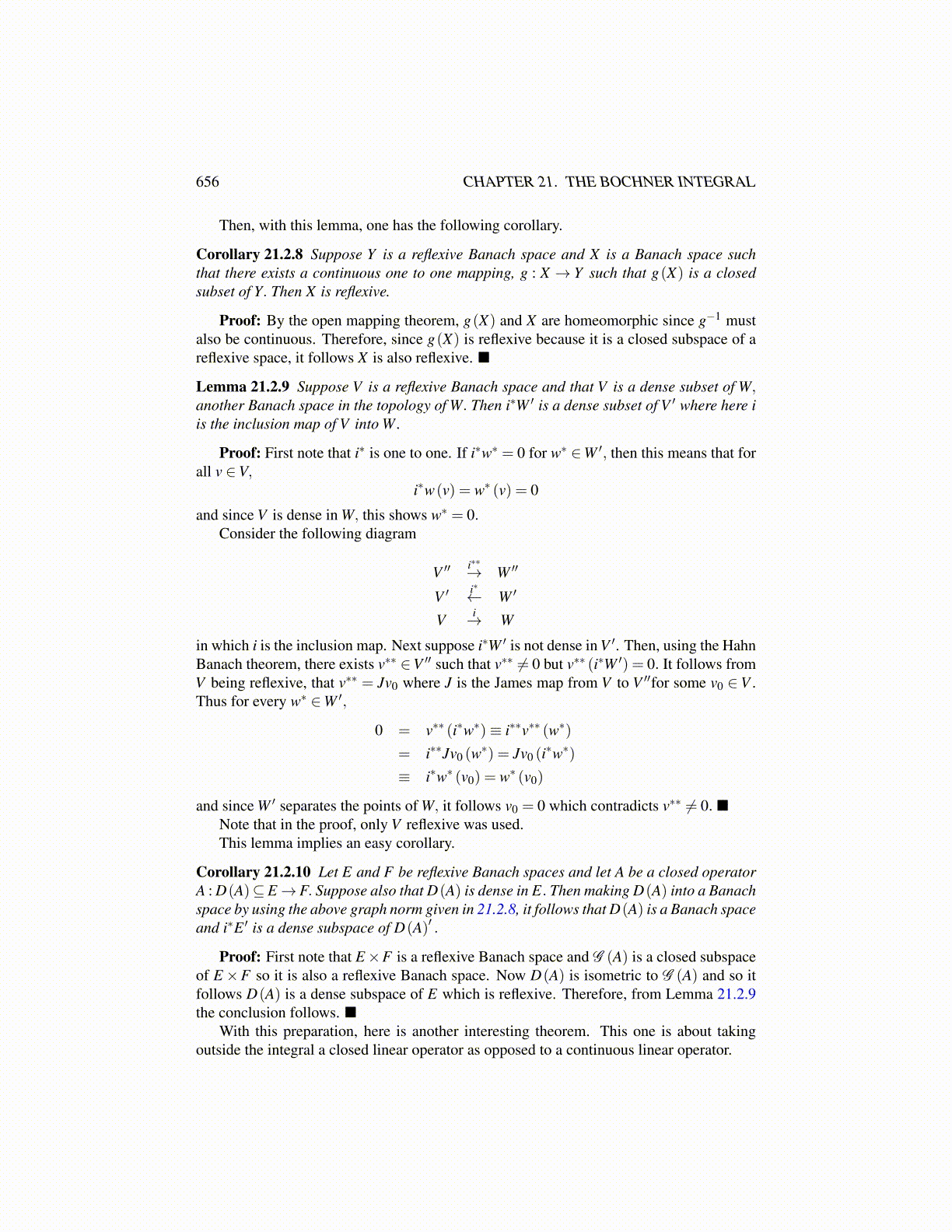
656 CHAPTER 21. THE BOCHNER INTEGRAL
Then, with this lemma, one has the following corollary.
Corollary 21.2.8 Suppose Y is a reflexive Banach space and X is a Banach space suchthat there exists a continuous one to one mapping, g : X → Y such that g(X) is a closedsubset of Y. Then X is reflexive.
Proof: By the open mapping theorem, g(X) and X are homeomorphic since g−1 mustalso be continuous. Therefore, since g(X) is reflexive because it is a closed subspace of areflexive space, it follows X is also reflexive.
Lemma 21.2.9 Suppose V is a reflexive Banach space and that V is a dense subset of W,another Banach space in the topology of W. Then i∗W ′ is a dense subset of V ′ where here iis the inclusion map of V into W.
Proof: First note that i∗ is one to one. If i∗w∗ = 0 for w∗ ∈W ′, then this means that forall v ∈V,
i∗w(v) = w∗ (v) = 0
and since V is dense in W, this shows w∗ = 0.Consider the following diagram
V ′′ i∗∗→ W ′′
V ′ i∗← W ′
V i→ W
in which i is the inclusion map. Next suppose i∗W ′ is not dense in V ′. Then, using the HahnBanach theorem, there exists v∗∗ ∈V ′′ such that v∗∗ ̸= 0 but v∗∗ (i∗W ′) = 0. It follows fromV being reflexive, that v∗∗ = Jv0 where J is the James map from V to V ′′for some v0 ∈ V .Thus for every w∗ ∈W ′,
0 = v∗∗ (i∗w∗)≡ i∗∗v∗∗ (w∗)
= i∗∗Jv0 (w∗) = Jv0 (i∗w∗)
≡ i∗w∗ (v0) = w∗ (v0)
and since W ′ separates the points of W, it follows v0 = 0 which contradicts v∗∗ ̸= 0.Note that in the proof, only V reflexive was used.This lemma implies an easy corollary.
Corollary 21.2.10 Let E and F be reflexive Banach spaces and let A be a closed operatorA : D(A)⊆E→F. Suppose also that D(A) is dense in E. Then making D(A) into a Banachspace by using the above graph norm given in 21.2.8, it follows that D(A) is a Banach spaceand i∗E ′ is a dense subspace of D(A)′ .
Proof: First note that E×F is a reflexive Banach space and G (A) is a closed subspaceof E×F so it is also a reflexive Banach space. Now D(A) is isometric to G (A) and so itfollows D(A) is a dense subspace of E which is reflexive. Therefore, from Lemma 21.2.9the conclusion follows.
With this preparation, here is another interesting theorem. This one is about takingoutside the integral a closed linear operator as opposed to a continuous linear operator.